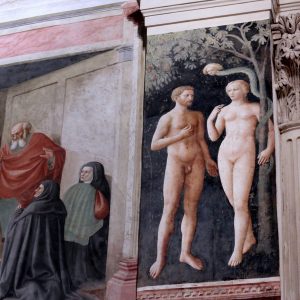Within the heart of Palermo, Sicily, lies a treasure trove of history and artistic splendour – the Palatine Chapel. Consecrated on Palm Sunday, April 28, 1140, this architectural marvel has unparalleled beauty and historical importance.
The Palatine Chapel serves as a beacon of religious and artistic significance and has rightfully earned its place on UNESCO’s prestigious World Heritage List.
The history of the Palatine Chapel is as captivating as its intricate artwork. Built during the Norman rule of Sicily, the chapel served as the royal chapel of the Norman kings. Roger II of Sicily commissioned the chapel, in 1132, a visionary ruler who sought to create a symbol of his power and prestige.
Designed by skilled craftsmen and artisans from various cultural backgrounds, the chapel reflects a unique blend of Norman, Byzantine, Arab, and Latin influences, embodying the diverse heritage of Sicily.
Incredible mosaics and ceiling
One of the most striking features of the Palatine Chapel is its breathtaking mosaics, which adorn the walls, arches, and dome of the chapel. These intricate mosaics, crafted by master artisans, depict biblical scenes, saints, and intricate geometric patterns, showcasing the exquisite craftsmanship and artistic prowess of the era.
The mosaics, known for their vibrant colours, intricate detailing, and symbolic significance, offer visitors a glimpse into the religious and cultural beliefs of the time.
The oldest mosaics, likely dating back to the earliest phases of construction, adorn the ceiling, drum, and dome of the chapel. Among the most dazzling are those in the transept, believed to have been created in the 1140s by Byzantine artists. These mosaics depict scenes such as St. John in the desert and a pastoral landscape featuring the Agnus Dei.
Along the north wall, a series of five saints, including the Greek fathers of the church, are depicted. They are St. Gregory of Nissa, St. Gregory the Theologian, St. Basil, St. John Chrysostom, and St. Nicholas, revered as the Three Great Orthodox Church Fathers, known as the Three Hierarchs. Notably, the central trio—St. Gregory, St. Basil, and St. John Chrysostom—, a designation established half a century prior. Each mosaic composition sits in a frame, reminiscent of the ornamental frames often seen in contemporary mosaic icons.
Muquarnas Ceiling
The intricately designed and visually striking muqarnas on the ceiling are a rare instance of non-Islamic elements within the region. Their sudden appearance in Sicily suggests such a sophisticated architectural system likely came from elsewhere.
The patterns and geometric motifs create an illusion of depth and movement, transforming the chapel into a celestial sanctuary bathed in golden light. As sunlight filters through the stained-glass windows, the ceiling seems to come alive, casting a spellbinding aura over the entire space.








